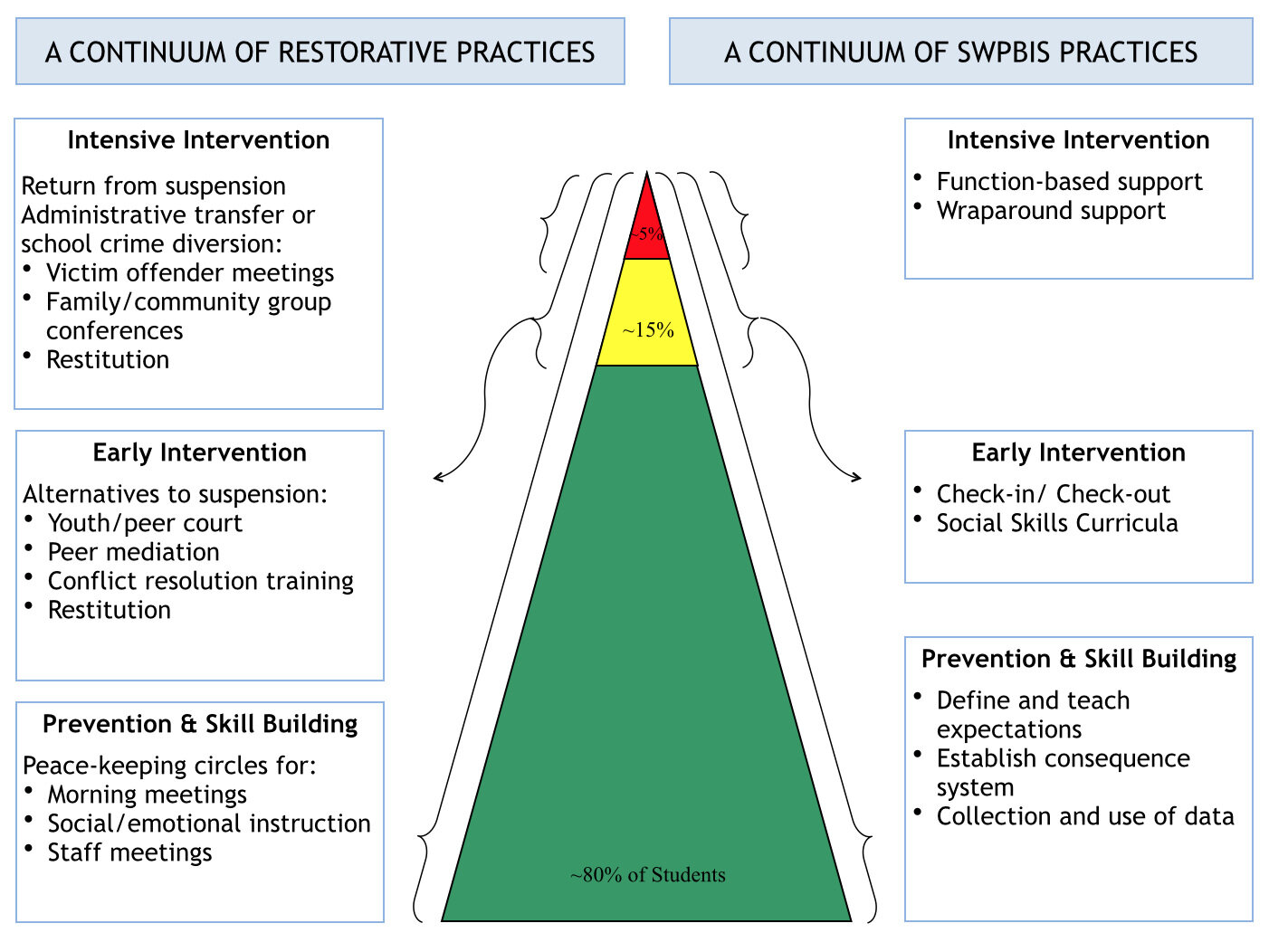Integrating Restorative Practices and PBIS
by: Beth Hampson
School discipline, classroom management and social and emotional learning cannot be separated. As schools look at new initiatives to address these fundamental aspects of teaching and learning the overlap of Restorative Practices, Positive Behavioral Interventions and Supports (PBIS), Trauma Informed Teaching and Social and Emotional Learning all work together to build safer more effective schools. In this post we will address how PBIS and Restorative Practices work together.
Positive Behavioral Interventions and Supports (PBIS) or School-wide Positive Behavior Support (SWPBS) are about systems and data-based decision making to support the needs of students in order to promote positive behavior and a positive classroom climate. PBIS/SWPBS promote the use of clear and consistent classroom expectations. Successful implementation requires on-going professional development, teacher buy-in, support from administration, coaching and practice. School-wide implementation generally takes 3-5 years.
Restorative Practices (RP) are focused on relationships with the goal of building strong connections that promote positive behavior and a positive classroom climate. RP provides structures and practices to set clear classroom expectations, as well as providing language for engaging students in problem-solving and self reflection when problems arise. Successful school-wide implementation requires on-going professional development, teacher buy-in, support from administration and coaching and practice. It takes approximately 3-5 years to fully implement.
Both seek to improve school/classroom climate, increase student achievement, build social and emotional capacity, improve emotional regulation, keep kids in the classroom, increase productive instructional time and improve teacher classroom management. The practices complement each other. PBIS is a system for building and evaluating positive behavioral outcomes. Restorative Practices provide tools for creating positive behavioral outcomes. The PBIS system can use Restorative Practices to meet the goals of providing clear, consistent routines and expectations that lead to better functioning classroom and school communities. The key to success for both is fidelity to the practice.
The list below, adapted from PBIS.org, shows the intersection of SWPBIS and RP.
SWPBIS and RP both include:
A Shared Philosophical Alignment
SWPBIS and RP are a response to zero tolerance policies
SWPBIS and RP are approaches to preventing, reducing and responding to problem behavior.
Both provide alternatives to how schools currently conceptualize discipline
SWPBIS provide systems to guide adult behavior
RP provide a range of alternative behaviors for adults to engage in that are not exclusionary reactions to misbehavior
Both reshape discipline through
A commonly agreed upon standard of conduct for adults and youth
Building positive relationships within the school community
Creating a sense of community and positive school wide climate
Maintaining student dignity
Utilizing misbehavior as learning opportunity
When the continuum of RP and the continuum of SWPBIS are overlaid we see that they align and support each other.
From: www.PBIS.org
So what does this alignment look like in schools? Below is an example of a PBIS framework that uses Restorative Practices for addressing problematic behavior. This framework provides the steps that teachers are expected to take when problematic behaviors occur.
When expectations are not met, use instructive and corrective consequences early and often
Correct behavior calmly and in a manner that demonstrates that the student is safe and supported at school
View inappropriate behavior as instructional opportunity; reteach expectations and allow the student to practice the expected behavior
Use consequences that promote student self-reflection: What harm was caused? What can be done to correct the harm? Why did the student make that choice? What could they have done differently? What help does the student need and from whom to make a different choice next time?
Communicate the importance of instructional time; correct student behavior and return them to instructional setting as quickly as possible.
Document the use of corrective consequences to track success.
Furthermore, staff is provided clear directive from the administration regarding how they should implement the practices in their classroom:
Restorative conversations should occur:
Preceding an office discipline referral
During the disciplinary process - by administration
Anytime they would be helpful
Post restorative conversation questions
Link the restorative conversation to the class values, the needs of other people or the impact of student behavior on others
At the beginning of the implementation process, please try to use the restorative questions as written.
Remember: this will be intentional work and will take time on the part of all staff.
For additional information check out FixSchoolDiscipline.org. This is a comprehensive guide that advocates for supportive and inclusive discipline policies that hold students accountable and improve school climate and safety through utilizing SWPBIS, Restorative Practices, Social and Emotional Learning and Trauma Sensitive Strategies.
See also: The Value of Utilizing Circles in Academic Classrooms

